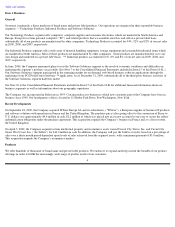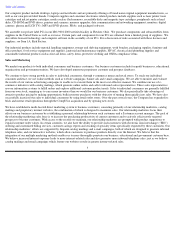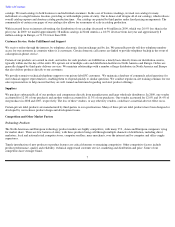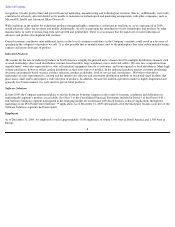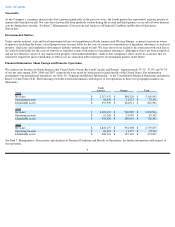Circuit City 2009 Annual Report Download - page 16
Download and view the complete annual report
Please find page 16 of the 2009 Circuit City annual report below. You can navigate through the pages in the report by either clicking on the pages listed below, or by using the keyword search tool below to find specific information within the annual report.
Table of Contents
For example, we currently have operations located in numerous countries outside the United States, and non-U.S. sales (Europe,
Canada and Puerto Rico) accounted for approximately 33.5% of our revenue during 2009. To the extent the U.S. dollar strengthens
against foreign currencies, our foreign revenues and profits will be reduced when translated into U.S. dollars.
•
We are exposed to various inventory risks, such as being unable to profitably resell excess or obsolete inventory and/or the loss of
product return rights and price protection from our vendors; such events could lower our gross margins or result in inventory write-
downs that would reduce reported future earnings.
Our inventory is subject to risk due to technological change and changes in market demand for particular products. If we fail to
manage our inventory of older products we may have excess or obsolete inventory. We may have limited rights to return purchases to
certain suppliers and we may not be able to obtain price protection on these items. The elimination of purchase return privileges and
lack of availability of price protection could lower our gross margin or result in inventory write-downs.
We also take advantage of attractive product pricing by making opportunistic bulk inventory purchases; any resulting excess and/or
obsolete inventory that we are not able to re-sell could have an adverse impact on our results of operations. Any inability to make
such bulk inventory purchases may significantly impact our sales and profitability.
•
If we fail to observe certain restrictions and covenants under our credit facilities the lenders could refuse to waive such default,
terminate the credit facility and demand immediate repayment, which would adversely affect our cash position and materially
adversely affect our operations.
Our United States/United Kingdom combined revolving credit agreement contains covenants restricting or limiting our ability to,
among other things:
•
incur additional debt
•
create or permit liens on assets
•
make capital expenditures or investments
•
pay dividends
If we fail to comply with the covenants and other requirements set forth in the credit agreement, we would be in default and would
need to negotiate a waiver agreement with the lenders. Failure to agree on such a waiver could result in the lenders terminating the
credit agreement and demanding repayment of any outstanding borrowings, which could adversely affect our cash position and
adversely affect the availability of financing to us, which could materially impact our operations.
•
We have experienced rapid growth in retail stores in North America and to maintain their profitability we must effectively manage
our growth and cost structure, such as inventory needs, point of sales systems, personnel and lease expense.
We have 34 retail stores in North America at December 31 2009, a significant increase over 2008. The Company needs to effectively
manage its cost structure in order to maintain profitability including the additional inventory needs, retail point of sales IT systems,
retail personnel and leased facilities. Future growth in retail will also be dependent on the ability to attract customers and build brand
loyalty. The retail computer and consumer electronics business is highly competitive and has narrow gross margins. If we fail to
manage our growth and cost structure while maintaining high levels of service and meeting competitive pressures adequately, our
business plan may not be achieved and may lead to reduced profitability .
14


